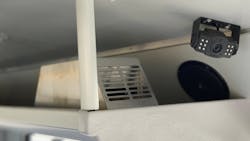Turlock Transit installs air purification system on buses
Active air purification technology has been installed on all Turlock Transit buses.
The equipment generates and distributes safe levels of naturally occurring hydroperoxides to actively and continually treat the air and surfaces. The system has been lab-tested and proven to eliminate nearly 99 percent of germs, microbes, viruses and bacteria from the air and on surfaces, including the SARS-CoV-2 virus.
“We’ve found most of the air treatment products on the market to be either unproven, unreliable, cost prohibitive or not designed for use in active transit operations,” said Wayne York, Transit manager. “We needed a solution that was based on proven technology, easy to install with minimal maintenance requirements and cost effective to purchase and operate. We are pleased to have found a viable solution with USSC.”
The equipment is based on ionized hydroperoxide technology developed by RGF Environmental, known as photohydroionization (PHI). The technology takes ambient moisture from the air, passes it across a rare metal catalyst and uses a broad-spectrum ultraviolet (UV) light to create hydroperoxides. This process requires electrical power to operate, but no chemicals, filters or additives.
At no point are passengers exposed directly to the UV light.
When installed in facilities or heavy-duty buses, the equipment is installed inside the existing Heating Ventilation and Air Conditioning (HVAC) systems so the treated air can be evenly disbursed. When installed on small or midsize buses, the equipment is configured differently, but still located near the HVAC system.
“As the first transit agency in California to install AirBubbl devices across our entire transit fleet in January 2021, actively filtering the air near each bus driver’s compartment, we’ve been on the forefront of applying innovative approaches to health and safety during the pandemic,” said York. “The deployment of this technology from USSC takes that commitment to the next level by allowing us to actively treat the air while the bus is in operation, giving passengers peace of mind when traveling, even after the current pandemic has ended. According to USSC, we are the first transit agency in the region to deploy this technology, as well.”
The city of Turlock, Calif., also purchased a product from USSC called AEGIS, an antimicrobial surface treatment that uses nanotechnology to render physical surfaces inhospitable for germs, bacteria and odors.
This liquid product is applied by an electrostatic sprayer to the interior of each bus and lasts for up to one year from the original application. Once applied, the product is resilient and cannot be removed by standard cleaners.
Funding for these capital investments were provided by transit-specific Local Transportation Funds. The cost for the equipment on-board the vehicles was $58,668, while the cost for the equipment at the Roger K. Fall Transit Center was $13,384. Installation of units at the transit center is expected to take place within the next month.
